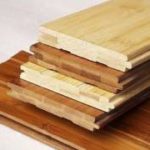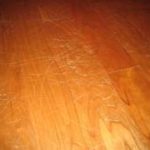Common types of stud wall insulation, specifications of their application. Technology of mounting the insulation material.
One of the main issues which one needs to decide on when building a stud wall house is a choice of stud wall insulation material. Let’s try to make a review of the basic materials and technologies that developers use for construction of a warm stud wall house on their own.
Rockwool mats
Working with slabs of rockwool does not require any additional equipment, the only tools you will need are a knife or a saw with fine tooth for cutting. Remember that they must fit snugly between the studs of the wall, filling the entire space, but it is strictly prohibited to compress or ram them!
Ecowool
 Ecowool is a completely natural material and it does not require the use of film, which is very important for those who want to make their home most environmentally friendly.
Ecowool is a completely natural material and it does not require the use of film, which is very important for those who want to make their home most environmentally friendly.
There are several ways to install ecowool into the frame. Dry insulation method presupposes manual steps: open the package and beat up its contents. The material is then placed in a wall by ramming, to achieve the required density, or blown by means of a special machine, which provides the desired packing density of the fibers.
Wet method. Ecowool is sprayed on the wall with the help of special equipment. In this case the fibers are like glued to the frame and to each other, which eliminates the possibility of shrinkage during operation of a house. Application of ecowool fibers is best carried out before the cladding.
Foam
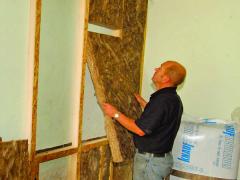 Main advantage of foam insulation is that it does not absorb moisture, and it doesn’t need any moisture and vapor protective membrane for the insulation. Pressed sheets of foam do not suit for the house insulation! Thermal insulation with foam is much cheaper than use of mineral wool mats or ecowool, but it requires greater accuracy and experience.
Main advantage of foam insulation is that it does not absorb moisture, and it doesn’t need any moisture and vapor protective membrane for the insulation. Pressed sheets of foam do not suit for the house insulation! Thermal insulation with foam is much cheaper than use of mineral wool mats or ecowool, but it requires greater accuracy and experience.
Sprayed insulation
Spray polyurethane foam presents two liquid components which are mixed with each other in various proportions and start to foam under the influence of air which is supplied under pressure. After it fills the entire space between the racks the surpluses are cut off. The result is a seamless monolithic surface excluding gaps and “cold joints”. Since the foam does not absorb moisture, additional membrane protection is also not required.
Polyurethane boards
When deciding on what insulation to use in stud walls, you may opt to boards made of rigid polyurethane foam. This material gains popularity throughout the world due to its high insulation quality, compatibility with most building facings, in-situ stability along with the ability to transmit water vapor.
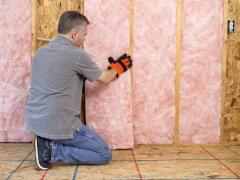 Measure the width of the gaps between the studs. Cut the board according to these measurements. To save time when dealing with large quantities, use a table saw or a box cutter. Attach a cut sheet to the wall: it must be held in place due to the tight placement between the studs. Caulk each board around or use expanding foam to improve energy efficiency and fix the boards.
Measure the width of the gaps between the studs. Cut the board according to these measurements. To save time when dealing with large quantities, use a table saw or a box cutter. Attach a cut sheet to the wall: it must be held in place due to the tight placement between the studs. Caulk each board around or use expanding foam to improve energy efficiency and fix the boards.
To solve the problem how to calculate the insulation, you must first decide on the type of insulation. Then, calculate the square of the insulated wall. For example, in the case of mineral wool slabs, wall square is divided to the square of one plate, and you get the desired amount of material. In the same way you need to calculate the required amount of waterproofing and vapor barrier materials considering the overlaps. Do not forget about calculating of additional wooden stubs for fixing the insulator plates.
Stages of stud wall insulation
Preparatory stage
The first step is to clean the wall surface of debris and dust. Further examination of the walls is made to find various defects. And basically it is necessary to remove the nails sticking out of the wall.
All gaps between the frame and the main wall and the junction between the wall and ceiling are sealed with polyurethane foam. Sometimes wooden walls absorb much moisture, so there is a need to dry the surface of the stud wall by a construction dryer.
The main stage – stud wall insulation
So, a first layer which is to cover the stud wall is a waterproofing material. It is designed to protect the insulation from moisture that penetrates through the stud wall inside the premises.
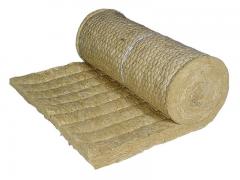 For waterproofing, you can choose roll material, such as glassine or roofing felt. It is attached to the wall by means of brackets and a stapler. Overlapping of roll edges varies between 4-6 inches.
For waterproofing, you can choose roll material, such as glassine or roofing felt. It is attached to the wall by means of brackets and a stapler. Overlapping of roll edges varies between 4-6 inches.
The next stage is laying the insulation. The material like mineral wool is placed only by stud method. You will have to set the vertical racks made of wooden slats with section of 25?25 or 25?30 mm. The distance between the racks is determined by the width of the mineral wool mats minus 2-3 inches (in order to install the wool mats without gaps).
Wooden rails are attached to the wall with nails or screws. Insulation is inserted into the space between the rails according to the wall height.
Once the mats are laid into the space between the racks they are isolated from moisture coming from inside and outside, using a vapor barrier membrane inside, wind barrier and waterproofing film outside the stud walls.
